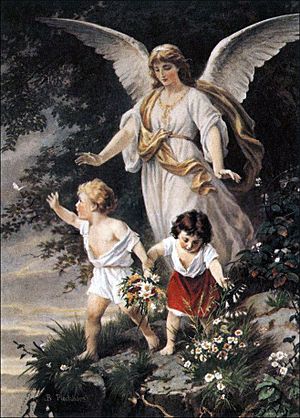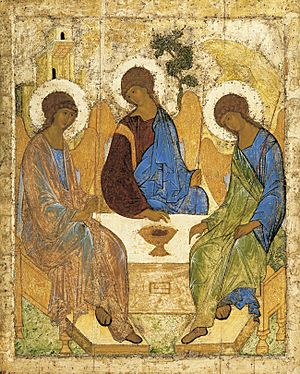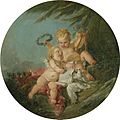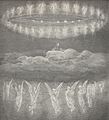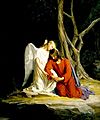Angel facts for kids
In many mythologies and religions, an angel is seen as a good spirit. The word "angel" comes from the Greek word angelos, which means "messenger". Angels are often mentioned in important religious texts like the Old Testament, the New Testament, the Quran, and the Aqdas.
Contents
Angels in Religious Texts
Angels are often described as powerful and wise spirits. They are believed to follow God's commands and praise him. Sometimes, they appear to humans in human form. They can bring messages to people directly or in dreams.
Famous Angels in the Bible
Some angels are named in the Bible:
- Michael is called a "chief prince."
- Gabriel is famous for telling Mary that she would be the mother of Jesus.
- Raphael is mentioned in the Apocryphal Book of Tobit.
The Ethiopian Book of Enoch also names four Archangels who watch over the four parts of heaven: Michael, Raphael, Gabriel, and Uriel. Some religious texts also mention angels who chose not to follow God.
Different Kinds of Angels
Religious texts describe different types of angels, each with unique features:
- Cherubim are often described as "winged creatures." They are said to have four wings and four faces. In the Book of Ezekiel, they are also described with "straight feet" and hands like a man under their wings. Cherubim are known for guarding the Garden of Eden with a sword of fire. They are also described as having wheels that move quickly through the sky.
- Seraphim means "burning." These angels are often shown with six wings. They are known for singing and praising God very loudly, sometimes even shaking the temple.
- Archangels are considered a very high type of angel. Gabriel is an example of an Archangel. In the Catholic Church, some Archangels are even considered saints.
Angels in Art
Angels are often shown in art with wings and a halo. The wings usually represent how fast they can move, and the halo shows their holiness.
In art, cherubim are often shown as baby-faced angels with small wings. However, in ancient descriptions, like those for the Temple of Solomon, cherubim were depicted as two four-winged creatures. Their wings touched over the Ark of the Covenant.
Studying Angels
The study of angels is called Angelology. It explores beliefs and ideas about angels from different religions and cultures.
Images for kids
-
The Archangel Michael wears a Roman military cloak and armor in this 17th-century picture by Guido Reni.
-
The Harmony between Religion and Science, a ceiling fresco by Paul Troger, 1735.
-
An allegory of poetry by François Boucher.
-
Jacob Wrestling with the Angel, by Gustave Doré in 1855.
-
Three angels hosted by Abraham, Ludovico Carracci (c. 1610–1612), Bologna, Pinacoteca Nazionale.
-
Tobias and the Angel by Filippino Lippi, created between c. 1472 and c. 1482.
-
The Divine Comedy, Paradise (Paradiso), illustration by Gustave Doré.
-
Kristus i Getsemane (1873), an angel comforting Jesus before his arrest in the Garden of Gethsemane, by Carl Heinrich Bloch (1834–1890).
-
Temple statue of the Angel Moroni, Bern, Switzerland.
-
A picture of an angel in a Persian miniature (Iran, 1555).
-
French Gothic angel from an altar, circa 1275–1300, made of oak with traces of paint.
-
Italian Gothic adoring angel, circa 1395–1396, made of marble from Carrara (Italy).
-
Southern German Baroque angel, by Ignaz Günther, circa 1760–1770, made of lindenwood.
-
Angels holding a red textile and a Baroque cartouche, in the Charlottenburg Palace (Berlin).
-
Arquebusier Angels, Colonial Bolivia, were part of the Cusco School.
-
The extraordinary-looking Cherubim (immediately to the right of Ezekiel) and Ophanim (the nested-wheels) appear in the chariot vision of Ezekiel.
-
Corinthian capital with an angel who holds a festoon with his wings, in Stiftskirche Mariae Himmelfahrt in Schlägl (Austria).
See also
 In Spanish: Ángel para niños
In Spanish: Ángel para niños


